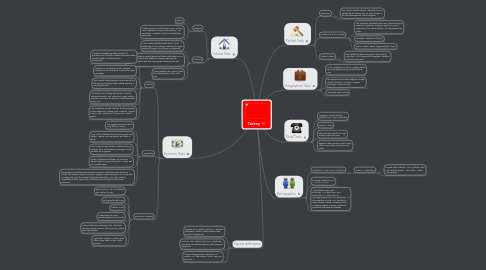
1. Exports and Imports
1.1. Exports: $143.4 billion from 2011: apparel, foodstuffs, textiles, metal manufactures, transport equipment
1.2. Imports: $232.9 billion from 2011: machinery, chemicals, semifinished goods, fuels, transport equipment
1.3. Major trading partners: Germany, UK, Russia, U.S., Italy, France, China, Iraq, Iran from 2011
2. Cultural Traits
2.1. Religion
2.1.1. Islamic
2.1.2. Muslims are to pray five times a day - at days, noon, afternoon, sunset, and evening. The exact time is posted in the local newspaper every day
2.2. Customs
2.2.1. When meeting shake hands firmly. When departing it is not always customary to shake hands although it is practiced occasionally
2.2.2. Friends and relations would greet each other with either one or two kisses on the cheek. Elders are always respected by kissing their right hand then placing the forehead onto the hand
2.2.3. When walking into a room, greet the oldest person in the room first
3. Economic Traits
3.1. Industry
3.1.1. Showed remarkable growth and level of production in this sector reached the world-wide standards after the liberalization movements
3.1.2. Subsectors of industry include: defense, electronics, iron and steel, automotive, glass and sugar
3.1.3. The cement industry plays an important role in the country holding a high-ranking position in world production
3.1.4. The textile and clothing sub-sector is another advanced branch, and Turkey, as a major cotton producer, increases its exports of textile products every year
3.1.5. Main industries include: textiles, food processing, autos, electronics, mining (coal, chromite, copper, boron), steel, petroleum, construction, lumber, paper
3.2. Agriculture
3.2.1. Has a great capacity to grow many kinds of crops
3.2.2. 70% of the cultivated land produces grain with wheat... Barley ranks as second, and corn as third
3.2.3. Corn requires humid water conditions during summer time, so the Black Sea Region is very suitable for its growth"
3.2.4. Lentils, chickpeas and beans are common. Broad beans and peas also grow in Turkey but on a smaller basis"
3.2.5. The growing of potatoes has recently increased. Industrial products such as cotton, flax, sesame seeds, and opium poppies have been grown for a long time in Turkey, but since the industrial developments after WWI new industrial vegetables such as sugar beet, sunflower seed and tea have also been produced
3.3. Economic Summary
3.3.1. GDP as of 2011: $1.075 trillion; per capita $14,400.
3.3.2. Real growth rate: 8.5%
3.3.3. Inflation: 6.5%
3.3.4. Unemployment: 9.8% (underemployment: of 4.0%)
3.3.5. Natural resources: antimony, coal, chromium, mercury, copper, borate, sulfur, iron ore, arable land, hydropower
3.3.6. Agriculture: tobacco, cotton, grain, olives, sugar beets, pulse, citrus; livestock
4. Social Traits
4.1. Language: Turkish (official), Kurdish, Dimli, Azeri, Kabardian
4.2. Capital: Ankara
4.3. Ethnicity/race: Turkish 70-75%, Kurdish 18% from 2008
4.4. Religion: Islam (mostly Sunni) 99.8%, other 0.2% (mostly Christians and Jews)
5. Political Traits
5.1. Parliament
5.1.1. The Turkish Grand National Assembly (TGNA), elected by all citizens over 19 years of age, is the direct descendant of the congress
5.2. President & Prime Minister
5.2.1. The president, elected by the TGNA from among its members, serves for one seven year term and is supposed to be 'above politics', and symbolizes the nation
5.2.2. President: Abdullah Gul (2007)
5.2.3. Prime Minister: Recep Tayyip Erdogan (2003)
5.3. Political Parties
5.3.1. Real multiparty democracy came into being in May after WWII (compared to England's tradition of almost 800 years)
6. Geographical Traits
6.1. At the northeast end of the Mediterranean Sea in southeast Europe and southwest Asia
6.2. Its neighbors are Greece, Bulgaria, Russia, Ukraine, Romania, Georgia, Armenia, Azerbaijan, Syria and Iraq
6.3. About the size of Texas
7. Demographics
7.1. Population: 72,561,312 in July 2012
7.1.1. Ankara: 4.338 million
7.1.1.1. Largest cities: Istanbul, 13.301 million; Izmir, 2.783 million; Bursa, 1.704 million; Adana, 1.609 million.
